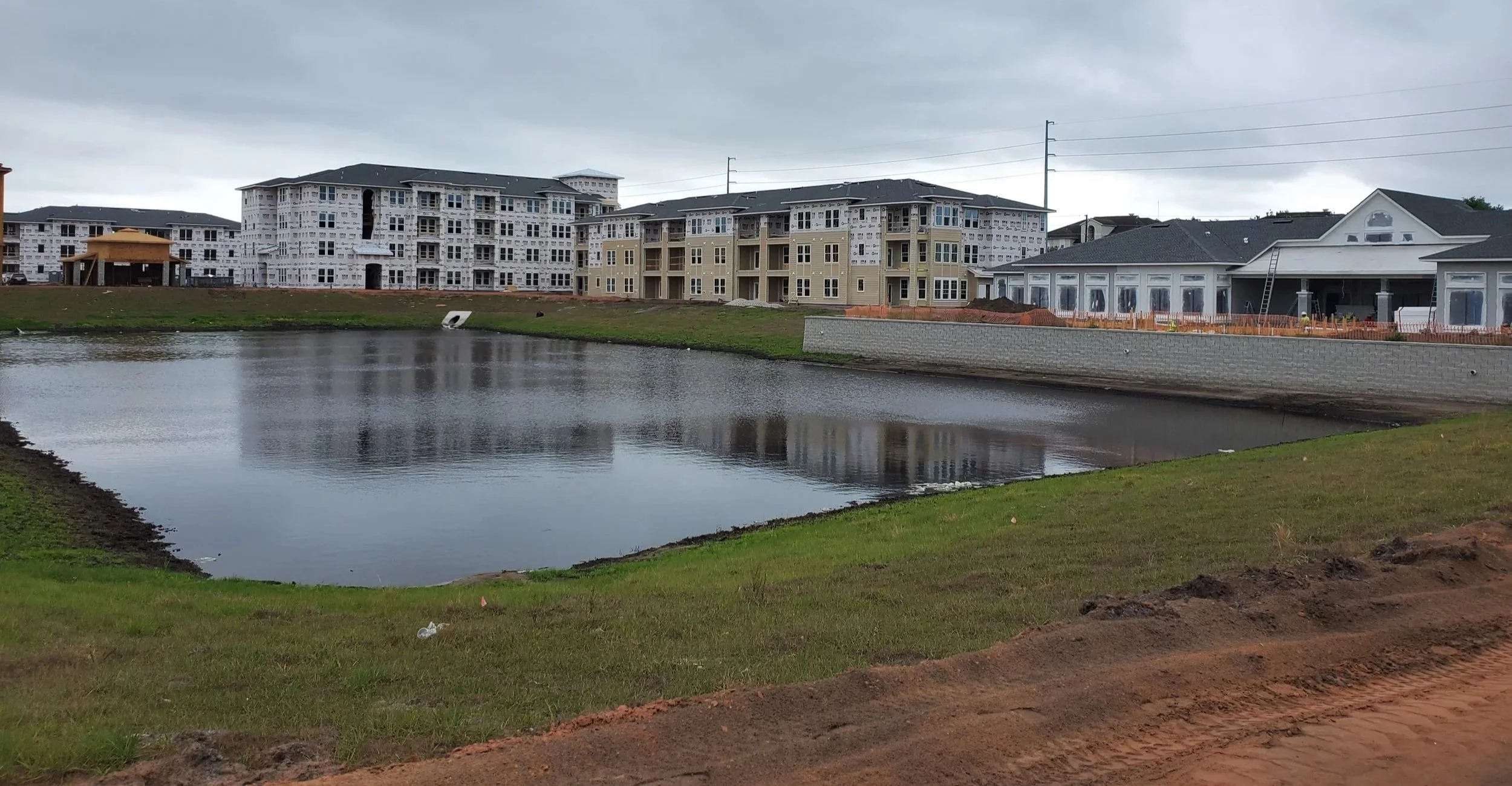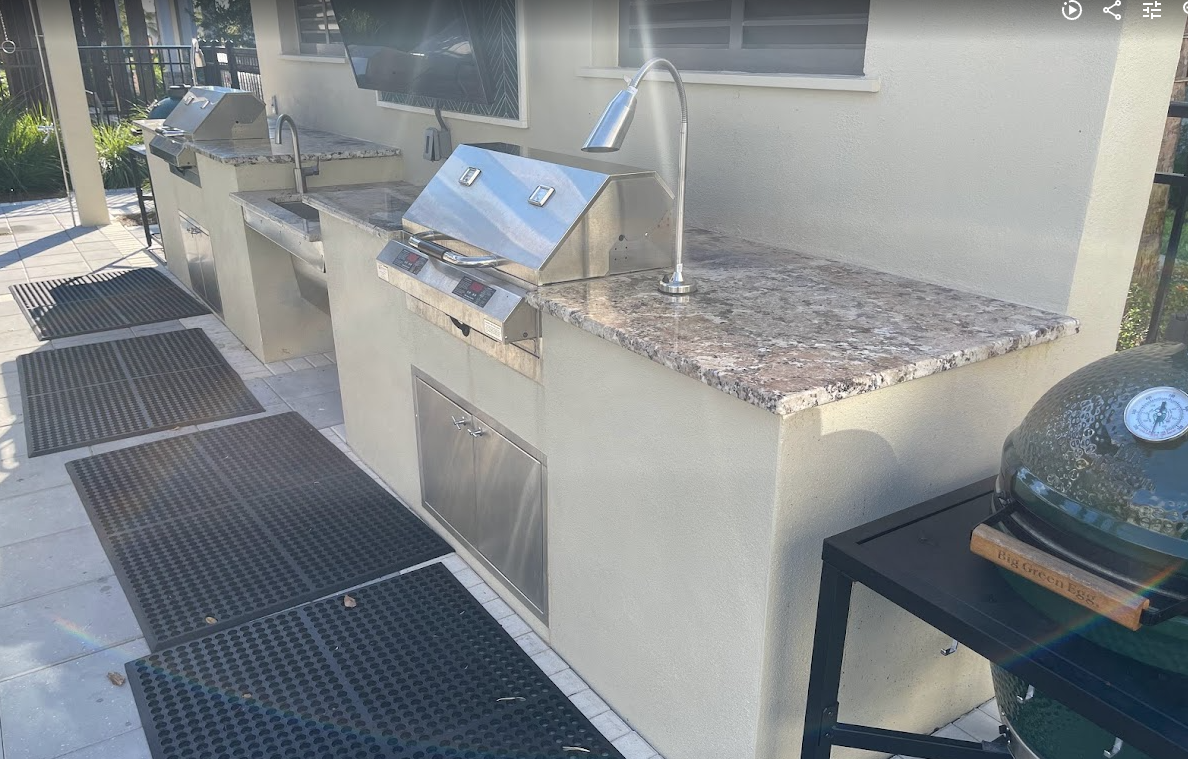Public vs. Not Public: A Practical Interpretation of “Public and Common Use” in Fair Housing Compliance
A professional perspective shaped by years of reviewing and inspecting Fair Housing Act projects
Multifamily housing development under construction with multiple three- and four-story residential buildings overlooking a retention pond.
When people talk about Fair Housing Act compliance, they often jump straight to the seven technical requirements inside covered dwelling units. While those requirements matter, many projects run into challenges long before anyone measures a threshold or checks a bathroom layout. One of the most overlooked and often misunderstood parts of Fair Housing Review happens at the very beginning: understanding what the FHA means by public use, common use, and private residential space.
This blog reflects how I approach these classifications in the field during Fair Housing inspections and plan reviews, and it also reflects the consistent method we use at ACI. Because the FHA is not written like a prescriptive building code, interpretation is part of the process. In my experience, getting the interpretation right early is one of the most effective ways to reduce risk and avoid costly corrections.
Why This Distinction Exists in Fair Housing Accessibility
The FHA’s design and construction requirements are intended to ensure equal access for people with disabilities across multifamily housing. The Fair Housing Design Manual organizes the built environment into three major categories:
Public use areas
Common use areas
Private dwelling units, where five of the seven FHA design requirements apply
These terms appear straightforward, but in practice, they are some of the most frequently misunderstood parts of any Fair Housing Review. Misinterpretation often begins when teams rely on everyday definitions instead of FHA intent.
Clarity at the outset prevents many of the disputes and redesigns I see later in development.
ACI’s Interpretation of What the FHA Design Manual Intends
The Design Manual uses “public and common use” repeatedly, but it does not always define them with real-world clarity. Below is the approach that consistently proves reliable during our Fair Housing inspections and reviews.
Close-up of a restroom sign labeled ‘104 Restrooms’ with tactile characters and Braille, mounted on a white wall near an interior door.
Public Use Areas
Public use areas are spaces where members of the public may enter while interacting with the property. Frequency does not matter. Restricted access does not matter. A gate, keypad, or appointment system does not change the classification.
If prospects or members of the public are expected to enter the space, it is public use.
Examples include:
Leasing offices
Model units
Public paths leading to leasing
Visitor parking
Any entrance used by prospects or tours
Teams often assume that a gated community is “not public.” The FHA focuses on expected interaction, not how a door is locked.
Outdoor common-use grilling station at a multifamily community. Features built-in grills, sinks, counters, overhead lighting, and rubber mats along the walkway.
Common Use Areas
Common use areas are shared by residents. If more than one resident uses the space, it is common use. Controlled access does not alter the category.
Common examples include:
Mail centers
Trash rooms
Clubhouses
Fitness centers
Pools
Amenity paths
Resident parking
A frequent mistake is assuming that “shared, but controlled access” equals private. The FHA does not interpret it that way. Function always determines classification.
Private Residential Areas
Private residential areas are the spaces intended for the use of a single resident. These areas are not classified as public use or common use. Examples include private garages, individual patios, and private storage rooms.
Private dwelling units themselves are subject to five FHA design requirements, including:
Interior accessible route
Door usability
Reach ranges
Bathroom reinforcement
Usable kitchens and bathrooms
Exterior private spaces like patios do not need to be accessible, but the route inside the dwelling unit leading to them must comply.
This nuance is often missed in both design reviews and Fair Housing inspections.
Where Misinterpretation Happens Most Often
Multifamily development site plan marked with red circles and arrows.
Across hundreds of Fair Housing reviews, the same issues appear repeatedly. These stem from applying everyday logic to terms that have very specific meanings under the FHA.
Leasing Office Entrances
If an entrance is used by prospects or residents, it must be treated as accessible. Intent is irrelevant if actual use differs.
Inside the Leasing Office
Even when the leasing office is not inside a covered multifamily building, the public areas within it remain subject to accessibility expectations. This includes:
Lobbies
Conference rooms
Public restrooms
Any service area used by prospects
Mail Centers
Mail centers are always common use, even when located in standalone kiosks or small buildings. Reach ranges and clear floor spaces must be included in Fair Housing design.
Parking Areas
Misclassification here is common:
Visitor parking = public use
Resident parking = common use
Failing to designate public-use parking near leasing areas is a frequent Fair Housing Review finding.
Pools and Clubhouses
If residents share it, it is common use.
If prospects are shown the space, it is temporarily public use.
Either way, accessibility applies.
Amenity Paths and Outdoor Features
Dog parks, trails, grilling stations, and outdoor fitness equipment all fall under common use when shared by residents.
Private Patios and Balconies
The balcony itself is private.
The interior route to it must still comply with FHA design requirements.
Corridors and Breezeways
These are common use circulation paths. Accessible route requirements apply throughout.
Trash Rooms and Package Rooms
Shared = common use
Monitored or access-controlled does not make them private.
Why Accurate Classification Matters
Getting public, common, and private classifications right at the beginning of a Fair Housing Review makes the rest of the project more predictable and reduces costly changes later.
Testers Focus on Public Use Areas First
Testing activity typically begins at:
Leasing paths
Public-use parking
Entrances
Model units
Routes used on tours
If these areas were misclassified during design, the project becomes immediately vulnerable to a complaint.
Corrections Are Expensive After Construction
Typical corrections resulting from misclassification include:
Regrading sidewalks
Reconfiguring parking or mail centers
Adjusting slopes at entrances
Installing new accessible routes
Rebuilding landings
Exterior work is especially costly due to its connection to grades, drainage, and elevations.
Lenders and Buyers Are Increasing Accessibility Scrutiny
Fair Housing compliance is now a common part of:
Acquisitions
Refinancing
Equity reviews
Property condition assessments
Correct classifications early protect owners during due diligence.
Design Teams Depend on Accurate Classification
Civil, architectural, MEP, and landscape teams all rely on these initial determinations. Misclassification leads to conflicting drawings, incorrect slopes, and missing accessible routes.
Contractors Build What Is Shown
Contractors build what is detailed in the drawings. If a space is misclassified on the plans, the constructed condition will reflect that same assumption. Contractors cannot be expected to infer accessibility requirements that were never documented
The Owner Retains Long-Term Exposure
Even after occupancy, classification errors can surface through:
Complaints
Testing
Renovations
Refinancing
Management transitions
Correct classification from day one reduces long-term operational risk.
How We Approach It at ACI
At ACI, our Fair Housing reviews focus on clarity, defensible interpretation, and the real-world use of the property. Rather than treating FHA terminology as abstract, we evaluate each space based on expected function.
Function Determines Classification
Prospects use the space = public use
Residents share it = common use
One resident uses it = private
Real-World Use Matters More Than Notes on a Sheet
If residents or staff use a route differently than intended in the drawings, FHA interpretation follows actual use.
The Five Internal FHA Requirements Are Non-Negotiable
We evaluate every covered unit for:
Door usability
Accessible route
Reach ranges
Bathroom reinforcement
Usable kitchen and bathroom layouts
We Review Drawings as a Connected System
We examine:
Elevations
Slopes
Parking relationships
Walks
Amenity access
Building entries
FHA issues appear where disciplines intersect.
We Favor Conservative, Defensible Interpretation
If a space could reasonably be public or common use, we treat it accordingly.
Our Process Focuses on Long-Term Risk Management
We evaluate how decisions today will perform:
During construction
During occupancy
During testing
During resale or refinancing
Durability matters.
Final Thoughts
Understanding how the FHA classifies public use, common use, and private residential areas is one of the foundational steps in Fair Housing compliance. These distinctions guide how routes are planned, how amenities are accessed, and how teams coordinate across disciplines.
Most confusion does not come from bad design. It comes from reasonable assumptions that do not match how the FHA Design Manual defines space. With consistent interpretation and clarity at the start, teams reduce risk and achieve smoother outcomes during construction, inspections, and occupancy.
If your team needs assistance interpreting these classifications or aligning design decisions with Fair Housing accessibility requirements, ACI is available to help.
Clear classifications lead to better coordination, fewer surprises, and a more efficient path through Fair Housing compliance.
Disclaimer: This content is for general informational purposes only and does not constitute legal or regulatory advice. Accessibility requirements vary by jurisdiction. Always consult federal, state, and local regulations and licensed professionals to ensure compliance.




